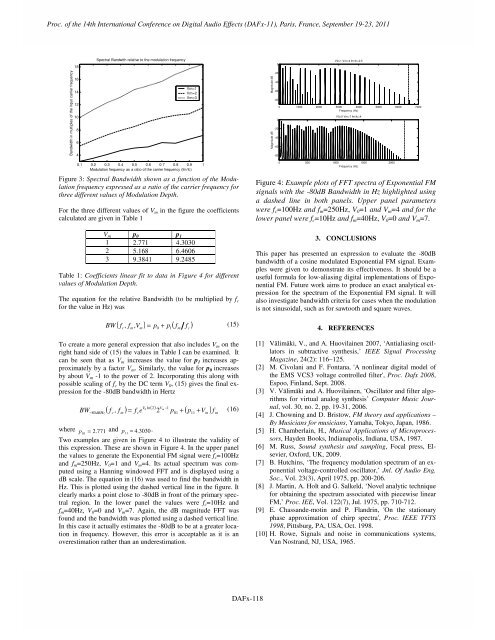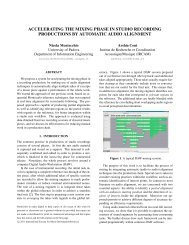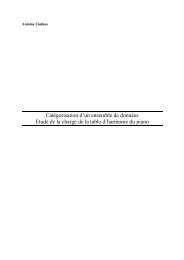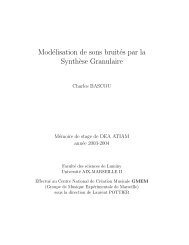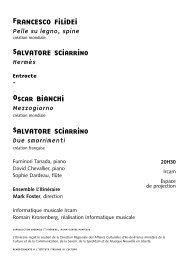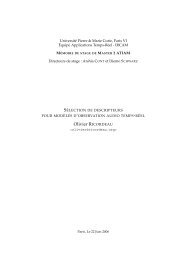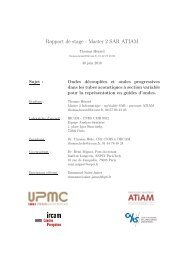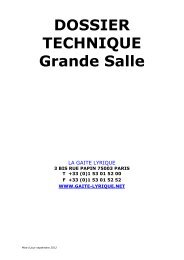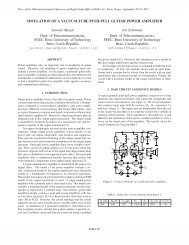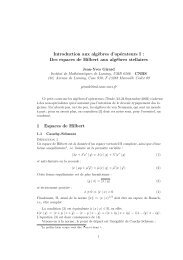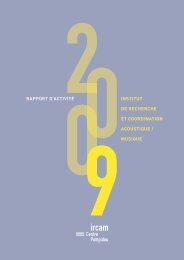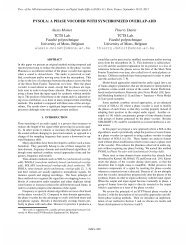EXPONENTIAL FREQUENCY MODULATION BANDWIDTH ...
EXPONENTIAL FREQUENCY MODULATION BANDWIDTH ...
EXPONENTIAL FREQUENCY MODULATION BANDWIDTH ...
Create successful ePaper yourself
Turn your PDF publications into a flip-book with our unique Google optimized e-Paper software.
Proc. of the 14th International Conference on Digital Audio Effects (DAFx-11), Paris, France, September 19-23, 2011Proc. of the 14 th Int. Conference on Digital Audio Effects (DAFx-11), Paris, France, September 19-23, 201118Spectral Bandwith relative to the modulation frequency0V0=1 Vm=4 fm/fc=2.5Bandwidth in multiples of the input carrier frequency16141210864Vm=1Vm=2Vm=3Magnitude dBMagnitude dB-20-40-60-800 1000 2000 3000 4000 5000 6000 7000Frequency (Hz)V0=0 Vm=7 fm/fc=40-20-40-60-800.1 0.2 0.3 0.4 0.5 0.6 0.7 0.8 0.9 1Modulation frequency as a ratio of the carrier frequency (fm/fc)Figure 3: Spectral Bandwidth shown as a function of the Modulationfrequency expressed as a ratio of the carrier frequency forthree different values of Modulation Depth.For the three different values of V m in the figure the coefficientscalculated are given in Table 10 500 1000 1500 2000Frequency (Hz)Figure 4: Example plots of FFT spectra of Exponential FMsignals with the -80dB Bandwidth in Hz highlighted usinga dashed line in both panels. Upper panel parameterswere f c =100Hz and f m =250Hz, V 0 =1 and V m =4 and for thelower panel were f c =10Hz and f m =40Hz, V 0 =0 and V m =7.V m p 0 p 11 2.771 4.30302 5.168 6.46063 9.3841 9.2485Table 1: Coefficients linear fit to data in Figure 4 for differentvalues of Modulation Depth.The equation for the relative Bandwidth (to be multiplied by f cfor the value in Hz) was( f , f , V ) p + p ( f f )BWc m m 0 1= (15)To create a more general expression that also includes V m on theright hand side of (15) the values in Table I can be examined. Itcan be seen that as V m increases the value for p 1 increases approximatelyby a factor V m . Similarly, the value for p 0 increasesby about V m -1 to the power of 2. Incorporating this along withpossible scaling of f c by the DC term V 0 , (15) gives the final expressionfor the -80dB bandwidth in HertzV ( ) V( fcfm) = fceln 2 −1p01+ ( p V m) f m0 mBW , + (16)−80dBHz211where p = 012. 771 and p11= 4. 3030.Two examples are given in Figure 4 to illustrate the validity ofthis expression. These are shown in Figure 4. In the upper panelthe values to generate the Exponential FM signal were f c =100Hzand f m =250Hz, V 0 =1 and V m =4. Its actual spectrum was computedusing a Hanning windowed FFT and is displayed using adB scale. The equation in (16) was used to find the bandwidth inHz. This is plotted using the dashed vertical line in the figure. Itclearly marks a point close to -80dB in front of the primary spectralregion. In the lower panel the values were f c =10Hz andf m =40Hz, V 0 =0 and V m =7. Again, the dB magnitude FFT wasfound and the bandwidth was plotted using a dashed vertical line.In this case it actually estimates the -80dB to be at a greater locationin frequency. However, this error is acceptable as it is anoverestimation rather than an underestimation.mc3. CONCLUSIONSThis paper has presented an expression to evaluate the -80dBbandwidth of a cosine modulated Exponential FM signal. Exampleswere given to demonstrate its effectiveness. It should be auseful formula for low-aliasing digital implementations of ExponentialFM. Future work aims to produce an exact analytical expressionfor the spectrum of the Exponential FM signal. It willalso investigate bandwidth criteria for cases when the modulationis not sinusoidal, such as for sawtooth and square waves.4. REFERENCES[1] Välimäki, V., and A. Huovilainen 2007, ‘Antialiasing oscillatorsin subtractive synthesis,’ IEEE Signal ProcessingMagazine, 24(2): 116–125.[2] M. Civolani and F. Fontana, 'A nonlinear digital model ofthe EMS VCS3 voltage controlled filter', Proc. Dafx 2008,Espoo, Finland, Sept. 2008.[3] V. Välimäki and A. Huovilainen, ‘Oscillator and filter algorithmsfor virtual analog synthesis’ Computer Music Journal,vol. 30, no. 2, pp. 19-31, 2006.[4] J. Chowning and D. Bristow, FM theory and applications –By Musicians for musicians, Yamaha, Tokyo, Japan, 1986.[5] H. Chamberlain, H., Musical Applications of Microprocessors,Hayden Books, Indianapolis, Indiana, USA, 1987.[6] M. Russ, Sound synthesis and sampling, Focal press, Elsevier,Oxford, UK, 2009.[7] B. Hutchins, ‘The frequency modulation spectrum of an exponentialvoltage-controlled oscillator,’ Jnl. Of Audio Eng.Soc., Vol. 23(3), April 1975, pp. 200-206.[8] J. Martin, A. Holt and G. Salkeld, ‘Novel analytic techniquefor obtaining the spectrum associated with piecewise linearFM,’ Proc. IEE, Vol. 122(7), Jul. 1975, pp. 710-712.[9] E. Chassande-motin and P. Flandrin, 'On the stationaryphase approximation of chirp spectra', Proc. IEEE TFTS1998, Pittsburg, PA, USA, Oct. 1998.[10] H. Rowe, Signals and noise in communications systems,Van Nostrand, NJ, USA, 1965.DAFX-4DAFx-118


